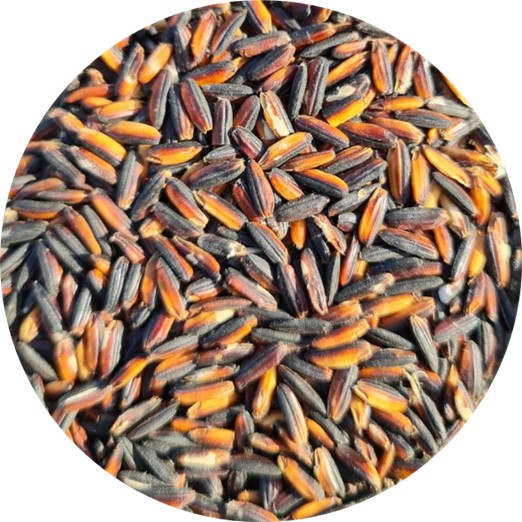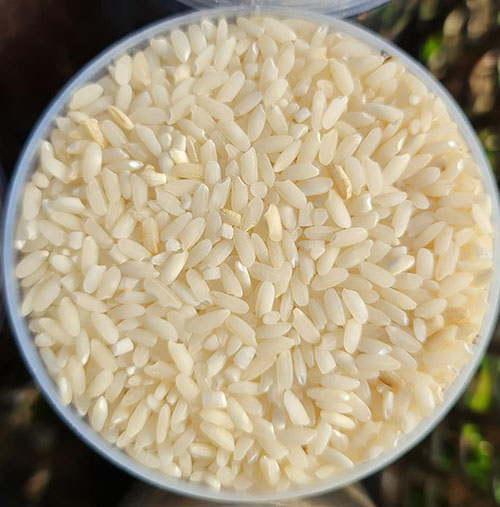BB3 CMU, PIS 1 CMU and KS5 CMU rice varieties may not be known to the general public, unlike the famous jasmine rice variety, but they contribute greatly to the world of rice for a number of reasons.
The North of Thailand may not be Thailand’s greatest rice growing region, but yet its mountainous topography and great swathes of forest contribute greatly to the diversification of rice. In fact, over 500 varieties of rice can be found in the North of Thailand, many with unique qualities such as cold-weather, pest, flood and disease resistance, as well as being highly nutritious in ways previously unknown. It just requires selection, classification and understanding.
Today, many of these varieties are disappearing due to the fact that farmers prefer to plant high-yielding commercially beneficial, mixed varieties of rice which can be cultivated year-round. But because these varieties of rice are invaluable to the country, the Lanna Rice Research Centre, Chiang Mai University was formed. The purpose of the centre is to collect, record and conserve Lanna rice varieties as well as conduct research, and act as coordinator between researchers in various fields of expertise such as the Faculties of Agriculture, Agro Industry, Medicine, Pharmacy, Science, Engineering, Economics, Business Management, and the Centre for the Promotion of Art and Culture.
In the past, the university’s academics studied rice from a myriad of perspectives, but now that the centre has been founded, academics can work on shared goals and strategies with the main purpose of researching, academic services and conserving Lanna rice varieties for a sustainable and valuable and sustainable future.
Since the formation of the centre, it has become abundantly clear that we are still learning about new varieties of rice which were previously unknown. Even though we eat rice daily, our knowledge of rice itself is relatively limited.
Getting to Know Lanna Rice
Farmer growing Karen rice variety in Mae Hong Son
Lanna rice varieties can be found across the Northern region, though most are found in Mae Hong Son province. The province is a mountainous region where multiple ethnic groups live and cultivate rice, producing varieties such as the Karen variety, etc. Most are grown at high altitude and often where water is constantly running through the fields. This can result in rice stems stretching up to avoid flooding, strengthening the variety’s resistance to floods.
The characteristics of the multitude of Lanna varieties are that they can be cultivated in high altitude and in cold weather, they are resistant to insects, disease and flooding and also are very high in nutrition, much more so than modern varieties of rice. The main reason for the collection of research data, however, is to keep a record of all known varieties of rice in the region, collecting a database of genetics which can be drawn upon to further develop the production of rice.
Associate Professor Dr. Chanakan Prom-u-thai, Director Lanna Rice Research Centre
“The reason we need to conserve these Lanna rice varieties is that there are many types of genes in rice,” explained Associate Professor Dr. Chanakan Prom-u-thai, Director of the Lanna Rice Research Centre. “Modern rice varieties are often preferred for their yield or flavour. However, in one variety of Lanna rice there can be many characteristics from disease and pest resistance, resistance to pH levels in the soil and flood resistance. Whenever a new variety of rice is being developed, we need to extract these genes and add them. It is therefore very important to have a database of genes and varieties so that we can select preferable characteristics in producing new varieties. Another reason is that when developing new varieties of rice, it is natural for one or two genes to disappear. It is therefore imperative that we collect them to be used in the future, otherwise these genes may be lost forever. Imagine if a disease or pest destroys all rice at one time, we will not have any way to redevelop the same rice with the same characteristics.”
One of the highlight varieties found in the North is the BB3 CMU variety, a round-shaped upland colourless milled rice, which is grown at an altitude of over 1,000 metres above sea level. The BB3 CMU variety is collected from the Karen variety of Theesa Village in Sop Moei District of Mae Hong Son Province. This rice has high yield as well as being nutritious with high levels of vitamin E. Rice bran is sold for extraction of vitamin E to be used as an ingredient for skin care products. This rice has officially received its registration and is in the process of being developed for commercial cultivation in the highlands.
PIS 1 CMU is a sticky upland dark rice also grown by the Karen people, in Pra Tu Muang Village, Mae Win Sub-district, Mae Wang District of Chiang Mai. Containing anthocyanin pigments, this rice is resistant to antioxidants, five times more than normal rice, which is useful in reducing cholesterol in the blood and balancing out the nervous system.
KS5 CMU is a black sticky rice, also from the Karen people, of Pang Kham Village, Pang Ma Pha Sub-district, Pang Ma Pha District of Mae Hong Son. High in phenolic compounds, it has properties resistant to cancer and wrinkles.
 |  |
| KS 5 CMU | BB 3 CMU
|
The research and development team from the Lanna Rice Research Centre and the Faculty of Agriculture, received joint funding from the Agriculture Research Development Agency (Public Organisation) to study all three of these varieties, officially registering them with the Department of Agriculture in 2020. This process required cooperation from farmers, who are integral to the development and successful application. It is therefore imperative that researchers always keep the needs of farmers in mind when conducting research, as the two go hand in hand.
“We have collected a very large genetics database of rice,” explained Associate Professor Dr. Chanakan. “We believe that this database has value to our nation. However, it may not be clear to farmers how valuable this database is, as for farmers, rice is a means for earning a living. We therefore must always keep their needs in mind and find ways to add value for farmers. Knowing that the Lanna varieties offer multiple characteristics from being high in vitamin E, antioxidants, irons and zinc, all of which modern varieties do not have anymore, we can promote these properties to farmers, encouraging them to grow local varieties alongside more commercial ones.”
Lanna Rice Research Centre
Integration of Knowledge for the Purpose of Adding Value
Interestingly, the Lanna Research Centre doesn’t have any researchers of its own. The purpose of the centre is in fact to act as coordinator and liaison between a multitude of researchers in a variety of fields from multiple faculties, all of which work on many aspects of research from upstream to downstream.
“The Lanna Rice Research Centre invites researchers from various departments to work on different aspects,” continued Associate Professor Dr. Chanakan “For instance, process researchers are invited from the Faculty of Agro Industry. Researchers from the Faculty of Pharmacy then may be invited to develop rice into shampoo or cream products. For product testing on mice or people, we invite researchers from the Faculty of Medicine. This is a system of networks with many willing contributors. Whenever we wish to create a project to develop a product, we will invite researchers from the Faculty of Agriculture to oversee the cultivation of rice, researchers from the Faculty of Pharmacy to develop the product, researchers from the Faculties of Business Administration and Mass Communications to work on marketing and public relations and researchers from the Faculty of Medicine too.”
The process of the centre begins with the development of rice varieties, the pre and post harvesting technology to impact yield and reduce cost to farmers, the setting up of distribution and sales systems at the lowest costs and most efficient speed through transport and logistics, imparting knowledge to farmers including technical knowledge on the production process, post-harvest management, storage, self-milling, as well as waste management or even recycling into eco-products which are biodegradable.
Rice can be processed into a variety of products, all of which can add value and be of use. Not only can rice be processed into a multitude of foods, but it can also be used in a variety of non-edible products. The Lanna Rice Research Centre has studied and developed many rice-based products. Rice products have medical and pharmaceutical value and can contribute to the marketplace to add value to multiple products whether it is rice oil, powdered drinks, or germinated brown rice ice cream. Rice waste also has value with brown rice bran extract being used in cosmetics, while the husk extract produces biotin peptide high in antioxidant which the body can easily absorb and helps fight against allergies. It is clear that Lanna rice varieties have multiple applications for modern farmers and modern living.
Workshop project on rice variety and applications in Sop Moei Sub-district, Mae Hong Son Province
Purple rice bran oil extracted
It is the teamwork of the contributors from so many faculties and departments to the Lanna Rice Research Centre which has led to its success. Working alongside farmers, listening to their problems, finding solutions, spreading knowledge, and promoting the appreciation of Lanna rice varieties, the Lanna Rice Research Centre is working to conserve a national treasure while also continuing to promote local culture of farmers across the north.